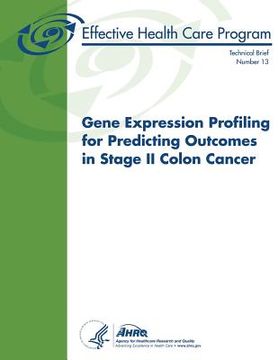Gene Expression Profiling for Predicting Outcomes in Stage II Colon Cancer: Technical Brief Number 13 (en Inglés)
Reseña del libro "Gene Expression Profiling for Predicting Outcomes in Stage II Colon Cancer: Technical Brief Number 13 (en Inglés)"
Colon cancer is a common malignancy affecting both women and men. In 2012, it is expected to be the fourth most commonly diagnosed cancer (after prostate, breast, and lung cancer) with an estimated 103,170 new cases and, combined with rectal cancer, is the second most common cause of cancer deaths (after lung cancer) with 51,690 deaths. The most important prognostic factor for colon cancer is stage at diagnosis. About 40 percent of patients with colon cancer are initially diagnosed with stage I disease (these localized tumors do not invade through the muscularis propria). Stage I disease has a 5-year survival rate of over 95 percent. Five-year survival rates for patients diagnosed with stage II disease are between 58 and 83 percent. Stage II colon cancer is characterized by full-thickness tumor invasion of the bowel wall and the absence of lymph node and distant metastases. Stage II disease is now subdivided into IIA (T3 tumors that invade through the muscularis propria into the pericolorectal tissues), IIB (T4a tumors that directly penetrate to the surface of the visceral peritoneum), and IIC (T4b tumors where tumor directly invades or is adherent to other organs or structures). The relative 5-year survival rate for stage II T4a tumors is higher than for T4b lesions. Stages III and IV have a worse prognosis. A number of negative prognostic factors, that is, factors associated with increased risk of recurrence, have been identified in stage II disease including T4 tumors (which tend to be large); obstruction or bowel perforation at initial diagnosis; an inadequately low number of assessed lymph nodes from surgery (12 or fewer); poorly differentiated histology, vascular, lymphatic, and perineural invasion; a high preoperative level of carcinoembryonic antigen; and the presence of indeterminate or positive resection margins. Gene expression profiles (GEPs), also known as gene expression patterns or signatures, measure the activity of "expression" of multiple genes using a single sample. Gene expression results from DNA transcription into messenger RNA (mRNA); mRNA then serves as the template for protein synthesis. Gene expression is determined by analyzing RNA in the sample, generally using either reverse transcription quantitative polymerase chain reaction or DNA microarrays. GEP tests use defined protocols to evaluate the specimens to be analyzed: preparing the RNA samples, copying into DNA, normalizing the raw expression measurements, and computing summary results (summary indices). Data from a GEP test can provide information about a cell's type, its current state of activity, and its local environment. This Brief will focus on the use of GEP tests for both prognostic and predictive outcomes. For the purposes of this Technical Brief, prognostic outcomes relate to disease prognosis such as recurrence of tumor or survival. The prognostic outcome often assesses disease recurrence over time (usually over 3 to 5 years) and is generally measured by disease-free survival. In contrast, use of GEP assays for predictive outcomes is different. This use correlates the GEP result with benefit (reduced recurrence rate and improved survival) from adjuvant chemotherapy. Predictive assays are especially important in that their use could result in improved survival.

